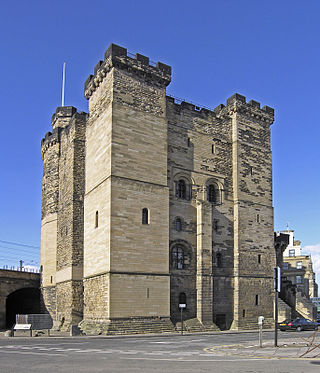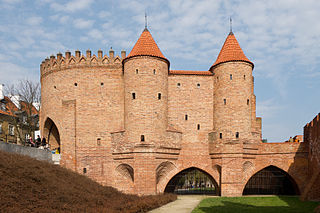
A barbican (from Old French : barbacane) is a fortified outpost or fortified gateway, such as at an outer defense perimeter of a city or castle, or any tower situated over a gate or bridge which was used for defensive purposes.

A barbican (from Old French : barbacane) is a fortified outpost or fortified gateway, such as at an outer defense perimeter of a city or castle, or any tower situated over a gate or bridge which was used for defensive purposes.

In the Middle Ages, barbicans were typically situated outside, or at the edge of, the main line of defenses, and were connected to the city walls with a walled road called the neck. They would thus defend the entrance to the city or castle at the "choke point". [1] In the 15th century, with the improvement in siege tactics and artillery, barbicans lost their significance. [2] Barbicans were built well into the 16th century. Fortified or mock-fortified gatehouses remained a feature of ambitious French and English residences well into the 17th century. Portuguese medieval fortification nomenclature uses barbican ("barbacã") to describe any wall outside of and lower than the main defensive wall that forms a second barrier. The barrier may be complete, extensive or only protect particularly weak areas. The more restrictive term gate barbican is used for structures protecting gates. [3]
The origin of the English word barbican is thought to be found in either Persian or Arabic (see here or here).
Paul Deschamps (1888–1974) interpreted the Arabic word 'bashura[h]' as used in 13th-century chronicles to mean barbican, a defensive structure placed ahead of a gate but this has been debunked, 'bashura' denoting rather an entire section of the outer fortifications, which may include a barbican but also a bastion, gate, tower or all of these. [4] [5]
Barbicans were also used in South Asian fortifications where some of their purposes were to protect the main gate from being rammed by war elephants. [6]
Fortifications in East Asia also feature similar high structures. In particular, gates in Chinese city walls were often defended by an additional "archery tower" in front of the main gatehouse, with the two towers connected by walls extending out from the main fortification. Literally called "jar walls", they are often referred to as "barbicans" in English. [7]

A castle is a type of fortified structure built during the Middle Ages predominantly by the nobility or royalty and by military orders. Scholars usually consider a castle to be the private fortified residence of a lord or noble. This is distinct from a mansion, palace, and villa, whose main purpose was exclusively for pleasance and are not primarily fortresses but may be fortified. Use of the term has varied over time and, sometimes, has also been applied to structures such as hill forts and 19th- and 20th-century homes built to resemble castles. Over the Middle Ages, when genuine castles were built, they took on a great many forms with many different features, although some, such as curtain walls, arrowslits, and portcullises, were commonplace.

A defensive wall is a fortification usually used to protect a city, town or other settlement from potential aggressors. The walls can range from simple palisades or earthworks to extensive military fortifications such as curtain walls with towers, bastions and gates for access to the city. From ancient to modern times, they were used to enclose settlements. Generally, these are referred to as city walls or town walls, although there were also walls, such as the Great Wall of China, Walls of Benin, Hadrian's Wall, Anastasian Wall, and the Atlantic Wall, which extended far beyond the borders of a city and were used to enclose regions or mark territorial boundaries. In mountainous terrain, defensive walls such as letzis were used in combination with castles to seal valleys from potential attack. Beyond their defensive utility, many walls also had important symbolic functions – representing the status and independence of the communities they embraced.

A fortification is a military construction designed for the defense of territories in warfare, and is used to establish rule in a region during peacetime. The term is derived from Latin fortis ("strong") and facere.

The Castle, Newcastle, or Newcastle Castle is a medieval fortification in Newcastle upon Tyne, England, built on the site of the fortress that gave the City of Newcastle its name. The most prominent remaining structures on the site are the Castle Keep, and the Black Gate, its fortified gatehouse.

Montagnana is a town and comune in the province of Padova, in Veneto. Neighbouring communes are Borgo Veneto, Casale di Scodosia, Urbana, Bevilacqua, Pojana Maggiore, Pressana, Minerbe and Roveredo di Guà. As of 2017, the population of Montagnana is 9120. The town was awarded with the Bandiera arancione and is one of I Borghi più belli d'Italia.

The Kraków Barbican is a barbican – a fortified outpost once connected to the city walls. It is a historic gateway leading into the Old Town of Kraków, Poland. The barbican is one of the few remaining relics of the complex network of fortifications and defensive barriers that once encircled the royal city of Kraków in the south of Poland. It currently serves as a tourist attraction and venue for a variety of exhibitions.

A gatehouse is a type of fortified gateway, an entry control point building, enclosing or accompanying a gateway for a town, religious house, castle, manor house, or other fortification building of importance. Gatehouses are typically the most heavily armed section of a fortification, to compensate for being structurally the weakest and the most probable attack point by an enemy. There are numerous surviving examples in France, Austria, Germany, England and Japan.

Chinese city walls refer to defensive walls built to protect important towns and cities in pre-modern China. In addition to walls, Chinese city defenses also included fortified towers and gates, as well as moats and ramparts around the walls.

The Warsaw Barbican is a barbican in Warsaw, Poland, and one of few remaining relics of the complex network of historic fortifications that once encircled Warsaw. Located between the Old and New Towns, it is a major tourist attraction.

St. Florian's Gate or Florian Gate in Kraków, Poland, is one of the best-known Polish Gothic towers, and a focal point of Kraków's Old Town. It was built about the 14th century as a rectangular Gothic tower of "wild stone", part of the city fortifications against Tatar attack.

Planty is one of the largest city parks in Kraków, Poland. It encircles the Stare Miasto , where the Medieval city walls used to stand until the early 19th century. The historic Old Town is not to be confused with the Administrative District No. 1 Stare Miasto extending further east.
Castles in Portugal were crucial components of the military throughout its history. The Portuguese learned the art of building fortifications from the Romans and the Moors. The Romans, who ruled and colonized the territory of current-day Portugal for more than four centuries, built forts with high walls and strong towers to defend their populations. The Moors, who invaded the Iberian Peninsula in the year 711 A.D., brought new stonework and heavily fortified gates to the peninsula.

The Walled City of Jajce is a medieval fortified nucleus of Jajce in Bosnia and Herzegovina, with Jajce Citadel high above town on top of pyramidal-shaped steep hill, enclosed with approximately 1,300 metres (4,300 ft) long defensive walls,. It is one of the best preserved fortified capitals of the Bosnian Kingdom, the last stronghold before the kingdom dissolved under the pressure of military advancement at the onset of Ottoman Empire takeover.
A gate tower is a tower built over or next to a major gateway.

Southampton's town walls are a sequence of defensive structures built around the town in southern England. Although earlier Roman and Anglo-Saxon settlements around Southampton had been fortified with walls or ditches, the later walls originate with the move of the town to the current site in the 10th century. This new town was defended by banks, ditches and the natural curve of the river and coastline. The Normans built a castle in Southampton but made no attempts to improve the wider defences of the town until the early 13th century, when Southampton's growing prosperity as a trading centre and conflict with France encouraged the construction of a number of gatehouses and stone walls to the north and east sides of the settlement.

A bridge castle is a type of castle that was built to provide military observation and security for a river crossing. In the narrower sense it refers to castles that are built directly on or next to a bridge. Sometimes, however, castles close to a bridge are referred to as bridge castles.

A Zwinger is an open kill zone area between two defensive walls that is used for defensive purposes. Zwingers were built in the post-classical and early modern periods to improve the defence of castles and town walls. The term is usually left untranslated, but is sometimes rendered as "outer courtyard", presumably referring to the subsequent role of a Zwinger as a castle's defences became redundant and it was converted into a palace or schloss; however, this belies its original purpose as a form of killing ground for the defence. The word is linked with zwingen, "to force", perhaps because the Zwinger forced an enemy to negotiate it before assaulting the main defensive line. Essenwein states that the "main purpose of this feature was so that the besieging force could not reach the actual castle wall very easily with battering rams or belfries, but had to stop at the lower, outer wall; also that two ranks of archers, behind and above one another, could fire upon the approaching enemy".
A fortified gateway is an element of a variety of fortified structures, such as a castle or walled town. Fortified gates or gateways appear in the Bronze Age and reach into the modern times.

Hohenfreyberg Castle, together with Eisenberg Castle directly opposite, forms a castle group in the southern Allgäu that is visible from a long way off. It is located about four kilometres north of Pfronten in the county of Ostallgäu. The late mediaeval hilltop castle was abandoned during the Thirty Years' War and set on fire. From 1995 to 2006 the former aristocratic seat was comprehensively made safe and conserved as part of a closely observed "example of renovation".